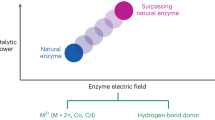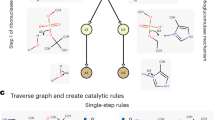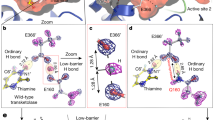Abstract
We have analysed enzyme catalysis through a re-examination of the reaction coordinate. The ground state of the enzyme–substrate complex is shown to be related to the transition state through the mean force acting along the reaction path; as such, catalytic strategies cannot be resolved into ground state destabilization versus transition state stabilization. We compare the role of active-site residues in the chemical step with the analogous role played by solvent molecules in the environment of the noncatalysed reaction. We conclude that enzyme catalysis is significantly enhanced by the ability of the enzyme to preorganize the reaction environment. This complementation of the enzyme to the substrate's transition state geometry acts to eliminate the slow components of solvent reorganization required for reactions in aqueous solution. Dramatically strong binding of the transition state geometry is not required.
This is a preview of subscription content, access via your institution
Access options
Subscribe to this journal
Receive 12 print issues and online access
$189.00 per year
only $15.75 per issue
Buy this article
- Purchase on Springer Link
- Instant access to full article PDF
Prices may be subject to local taxes which are calculated during checkout
Similar content being viewed by others
References
Haldane, J.B.S. Enzymes. Green and Co.: London, 1930.
Pauling, L. Molecular architecture and biological reactions. Chem. Engng News 24, 1375–1377 (1946).
Pauling, L. Nature of forces between large molecules of biological interest. Nature, 161, 707–709 (1948).
Bruice, T.C. & Pandit, U.K. Intramolecular models depicting the kinetic importance of “fit” in enzymatic catalysis. Proc. Natl. Acad. Sci. USA, 46, 402–404 (1960).
Page, M.I. & Jencks, W.P. Entropic contributions to rate accelerations in enzymic and intramolecular reactions and the chelate effect. Proc. Natl. Acad. Sci. USA 68, 1678–1683 (1971).
Jencks, W.P. Binding energy, specificity and enzymic catalysis - the Circe effect. Adv. Enzmol. Relat. Areas Mol. Biol. 43, 219–410 (1975).
Schowen, R.L. Transition States of Biochemical Processes, chapter 2 (Plenum Press, New York, 1978).
Menger, F.M. On the source of ilntramolecular and enzymatic reactivity. Acc. Chem Res. 18, 128–134 (1985).
Knowles, J.R. Enzyme catalysis: not different, just better. Nature 350, 121–124 (1991).
Radzicka, A. & Wolfenden, R. A proficient enzyme. Science 267, 90–93 (1995).
Kraut, J. How do enzymes work? Science 242, 533–540 (1988).
Wolfenden, R. Analog approaches to the structure of the transition state in enzyme reactions. Acc. Chem. Res. 5, 10–18 (1972).
Fersht, A. Enzyme structure and mechanism. (W.H. Freeman and Co., New York, 1985).
Menger, F.M. Analysis of ground-State and transition-state effects in enzyme catalysis. Biochemistry 31, 5368–5373 (1992).
Murphy, D.J. Revisiting ground state and transition state effects, the split-site model, and the “Fundamentalist Position” of Enzyme Catalysis. Biochemistry 34, 4507–4510 (1992).
Amadei, A., Linssen, A.B.M. & Berendsen, H.J.C. Essential dynamics of proteins. Proteins Struct. Funct. Genet. 17, 412–425 (1993).
Hayward, S., Kitao, A., G\=o, N. Harmonic and anharmonic aspects in the dynamics of BPTI: A normal mode analysis and principal component analysis. Prot. Sci. 3, 936–943 (1994).
McCammon, J.A. & Harvey, S.C. Dynamics of Proteins and Nucleic Acids. (Cambridge University Press, New York 1987).
Ben-Naim, A. Statistical Thermodynamics for Chemist and Biochemists 282–292 (Plenum Press, New York 1992).
Northrup, S.H., Pear, M.R., Lee, C., McCammon, J.A. & Karplus, M. Dynamical theory of activated processes in globular proteins. Proc. Natl. Acad. Sci. USA 79, 4035–4039 (1982).
vanderZwan, G. & Hynes, J.T. Nonequilibrium solvation dynamics in solution reactions. J. Chem. Phys. 78, 4174–4185 (1983).
Austin, R.H., Beeson, K.W., Einstein, L., Frauenfelder, H. & Gunalus, I.C. Dynamics of ligand binding to myoglobin. Biochemistry 14, 5355–5373 (1975).
Hagen, S.J., Hofrichter, J. & Eaton, W.A. Protein reaction kinetics in a room-temperature glass. Science 269, 959–962 (1995).
Tonge, P.J. & Carey, P.R. Forces, bond lengths, and reactivity: fundamental insight into the mechanism of enzyme catalysis. Biochemistry 31, 9122–9125 (1992).
Albery, W.J. & Knowles, J.R. Evolution of enzyme function and the development of catalytic efficiency. Biochemistry 15, 5631–5640 (1976).
Fierke, C.A. & Jencks, W.P. Two functional domains of coenzyme A activate coenzyme a transferase. J. Biol. Chem. 261, 7603–7606 (1986).
Whitty, A., Fierke, C.A. & Jencks, W.P. Role of binding energy with coenzyme A in catalysis by 3-oxoacid coenzyme a transferase. Biochemistry 34, 11678–11689 (1995).
Jones, P.G. & Kirby, A.J. Simple correlation between bond length and reactivity. Combined use of crystallographic and kinetic data to explore a reaction coordinate. J. Am. Chem. Soc. 106, 6207–6212 (1984).
Warshel, A., Naray-Szabo, G., Sussman, F. & Hwang, J.K. How do serine proteases really work? Biochemistry 28, 3629–3637 (1989).
Deng, H., Zheng, J., Clarke, A., Holbrook, J.J., Callender, R. & Burgner, J.W. Source of catalysis in dehydrogenase system. Ground-state interactions in the enzyme-substrate complex. Biochemistry 33, 2297–2305 (1994).
Kramers, H.A. Brownian motion in a field of force and the diffusion model of chemical reactions. Physica 7, 284 (1940).
Lumry, R.B. Protein Solvent Interactions, (ed. R.B. Gregory) 1–141 (Marcel Dekker: New York 1995).
Cooper, A. & Dryden, D.T.F. The Enzyme Catalytic Process. (eds. A. Cooper, J.L Houben, L.C. Chien) 159–171 (Plenum Press, New York 1988).
Steinfeld, J.I., Francisco, J.S. & Hase, W.L. Chemical Kinetics and Dynamics 357–360 (Prentice Hall, New York 1989).
McQuarrie, D.A. Statistical Mechanics 57–60 (Harper and Row, New York 1976).
Privalov, P.L. & Makhatadze, G.I. Heat capacity of proteins. II. Partial heat capacity of the unfolded polypeptide chain of proteins: Protein unfolding efects. J. Mol. Biol. 213, 385–391 (1990).
Gomez, J., Hilser, V.J., Xie, D. & Freire, E. The heat capacity of proteins. Proteins Struct. Funct. Genet. 22, 404–412 (1995).
Zhu, L., Sage, J.T. & Champion, P.M. Observation of coherent reaction dynamics in heme proteins. Science 266, 629–632 (1994).
Petrich, J.W., Martin, J.L., Houde, D., Poyart, C. & Orszag, A. Time-resolved Raman spectroscopy with subpicosecond resolution: Vibrational cooling and delocalization of strain energy in photodissociated (carbonmonoxy)hemoglobin. Biochemistry 26, 7914–7923 (1987).
Lingle Jr., R., Xu, X., Zhu, H., Yu, S.C. & Hopkins, J.B. Direct observation of hot vibrations in photoexcited deoxyhemoglobin using picosecond Raman spectroscopy. J. Am. Chem. Soc. 113, 3992–3994 (1991).
Li, P., Sage, J.T. & Champion, P.M. Probing picosecond processes with nanosecond lasers: Electronic and vibrational relaxation dynamics of heme proteins. J. Chem. Phys. 97, 3214–3227 (1992).
Miller, R.J. Energetics and dynamics of deterministic protein motion. Acc. Chem. Res. 27, 145–150 (1994).
Northrup, S.H. & McCammon, J.A. Gated reactions. J. Am. Chem. Soc. 106, 930–934 (1984).
Frauenfelder, H. & Wolynes, P.G. Rate theories and puzzles of hemeprotein kinetics. Science 229, 337–345 (1985).
Quiocho, F.A. Atomic structures of periplasmic binding proteins and the high-affinity active transport systems in bacteria. Phil. Trans. R. Soc. Lond. B 326, 341–352 (1990).
Wolfenden, R. Enzyme catalysis: Conflicting requirement of substrate access and transition state affinity. Mol. Cell. Biochem. 3, 207–211 (1974).
Maroncelli, M., Maclnnis, J. & Fleming, G.R. Polar solvent dynamics and electron-transfer reactions. Science 243, 1674–1681 (1989).
Gertner, B.J., Whittnell, R.M., Wilson, K.R. & Hynes, J.T. Activation to the transition state: Reactant and solvent energy flow for a model SN2 reaction in water. J. Am. Chem. Soc. 113, 74–87 (1991).
Doster, W., Cusack, S. & Petry, W. Dynamical transition of myoglobin revealed by inelastic neutron scattering. Nature 337, 754–756 (1989).
Dewan, R.F.T.J.C. & Petsko, G.A. Effects of temperature on protein structure and dynamics: X-ray crystallographic studies of the protein ribonuclease-A at nine different temperatures from 98 to 320 K. Biochemistry 31, 2469–2481 (1992).
Rasmussen, B.F., Stock, A.M., Ringe, D. & Petsko, G.A. Crystalline ribonuclease A loses function below the dyanmical transition at 220 K. Nature 357, 423–424 (1992).
Parak, F. et al. Evidence for a correlation between the photoinduced electron transfer and dynamic properties of the chromatophore membranes from Rhodospirillum rubrum. FEBS Letters 117, 368–372 (1980).
Nocek, J.M. et al. Low-temperature, cooperative conformational transition within [Zn-cytochrome c peroxidase, cytochrome c] complexes: Variation with cytochrome. J. Am. Chem. Soc. 113, 6822–6831 (1991).
Iorio, E.D. Protein dynamics. FEBS Letters 307, 14–19 (1992).
Loncharich, R.J. & Brooks, B.R. Temperature dependence of dynamics of hydrated myoglobin. J. Mol. Biol. 215, 439–455 (1990).
Smith, J., Kuczera, K. & Karplus, M. Dynamics of myoglobin: comparison of simulation results with neutron scattering spectra. Proc. Natl. Acad. Sci. USA 87, 1601–1605 (1990).
More, N., Daniel, R.M. & Petach, H.H. The effect of low temperature on enzyme activity. Biochem. J. 305, 17–20 (1995).
Warshel, A. Dynamics of enzymatic reactions. Proc. Natl. Acad. Sci. USA 81, 444–448 (1984).
Xu, D., Martin, C. & Schulten, K. Molecular dynamics study of early picosecond events in the Bacteriorhodopsin photocycle: Dielectric response, vibrational cooling and the J, K intermediates. Biophys. J. 70, 453–460 (1996).
Fierke, C.A., Johnson, K.A. & Benkovic, S.J. Construction and evaluation of the kinetic scheme associated with dihydrofolate reductase from Escherichia coli. Biochemistry 26, 4085–4092 (1987).
Rejto, P.A., Bindwald, E. & Chandler, D. Visualization of fast energy flow and solvent caging in unimolecular dynamics. Nature 375, 129–131 (1995).
Bruice, T.C. & Benkovic, S.J. Bioorganic Mechanisms (W.A. Benjamin, New York 1966).
Page, M.I. The energetics of neighbouring group participation. Chem. Soc. Rev. 2, 295–323 (1973).
Kati, W.M. & Wolfenden, R. Contribution of a single hydroxyl group to transition-state discrimination by adenosine deaminase: Evidence for an “Entropy Trap” mechanism. Biochemistry 28, 7919–7927 (1989).
Lightstone, F.C. & Bruice, T.C. Ground state conformations and entropic and enthalpic factors in the efficiency of intramolecular and enzymatic reactions. I. Cyclic anhydride formation by substituted glutarates, succinate and 3,6-Endoxo-δ-tetrahydrophthalate. J. Am. Chem. Soc. 118, 2595–2605 (1996).
Zhang, B. ; Breslow, R. Enthalpic domination of the chelate effect in cyclodextrin dimers. J. Am. Chem. Soc. 115, 9353–9354 (1993).
Orgel, L.E. An introduction to transition-metal chemistry: Ligand-field theory 14–16 (Methuen and Co. London, 1966).
Chervenak, M.C. & Toone, E.J. A direct measure of the contribution of solvent reorganization to the enthalpy of ligand binding. J. Am. Chem. Soc. 116, 10533–10539 (1994).
Author information
Authors and Affiliations
Rights and permissions
About this article
Cite this article
Cannon, W., Singleton, S. & Benkovic, S. A perspective on biological catalysis. Nat Struct Mol Biol 3, 821–833 (1996). https://doi.org/10.1038/nsb1096-821
Issue Date:
DOI: https://doi.org/10.1038/nsb1096-821
This article is cited by
-
The catalytic mechanism of direction-dependent interactions for 2,3-dihydroxybenzoate decarboxylase
Applied Microbiology and Biotechnology (2023)
-
Enzyme-mimetic self-catalyzed polymerization of polypeptide helices
Nature Communications (2019)
-
Ligand-induced substrate steering and reshaping of [Ag2(H)]+ scaffold for selective CO2 extrusion from formic acid
Nature Communications (2016)
-
Differences in the Abilities to Mechanically Eliminate Activation Energies for Unimolecular and Bimolecular Reactions
Scientific Reports (2016)
-
Structural basis for an inositol pyrophosphate kinase surmounting phosphate crowding
Nature Chemical Biology (2012)



